|
 Lactarius umerensis Lactarius umerensis
BiostatusPresent in region - Indigenous. Endemic
Images (click to enlarge)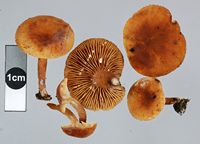
Owner: J.A. Cooper | 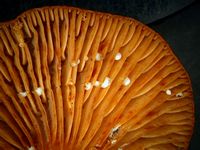
Caption: milk on gills
Owner: J.A. Cooper | 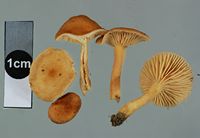
Owner: J.A. Cooper | 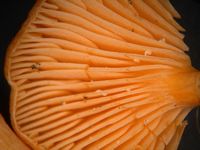
Owner: J.A. Cooper | 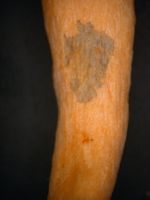
Caption: Upper: guaiac. Lower FeSO4.
Owner: J.A. Cooper | 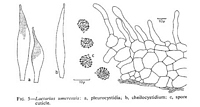 | 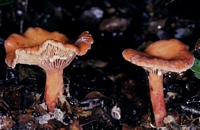
Owner: Herb. PDD | 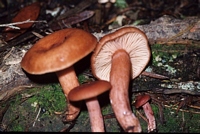
Owner: Herb. PDD | 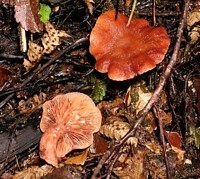
Caption: FUNNZ photo
Owner: J.A. Cooper | 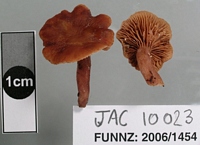
Caption: FUNNZ photo
Owner: J.A. Cooper | 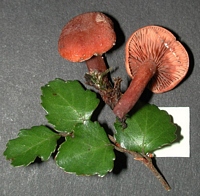
Owner: J.A. Cooper | 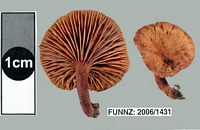
Owner: J.A. Cooper | 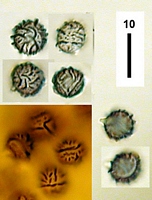
Caption: spores
Owner: J.A. Cooper | 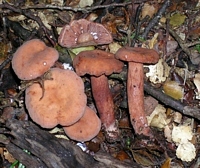
Owner: J.A. Cooper | 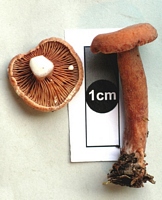
Owner: J.A. Cooper | 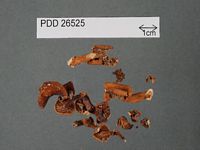
Caption: Dried type specimen
Owner: Herb PDD | 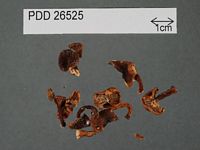
Caption: Dried type specimen
Owner: Herb PDD |
Article: McNabb, R.F.R. (1971). The Russulaceae of New Zealand. 1. Lactarius DC ex S.F. Gray. New Zealand Journal of Botany 9(1): 46-66 (http://www.rsnz.org/publish/abstracts.php).
Description: pileus: 1-3.5 cm diam., convex when young, plano-convex, applanate, or centrally depressed at maturity, slightly viscid under wet conditions, otherwise dry, innately pruinose to finely subtomentose under lens, azonate, smooth or faintly rugulose in older fructifications, sordid salmon, dull greyish orange, or pallid orange-brown; margins entire, slightly involute at maturity, occasionally faintly pectinate in old fructifications, often more tomentose than remainder of pileus. Cuticle often disorganised at maturity, composed of erect, thin-walled, hyaline, septate, filamentous hyphae to 100 µm long, 6-10 µm diam., originating from exterior cells of a well-defined cellular layer. lamellae: adnate, sub-decurrent, or occasionally decurrent, crowded, moderately thick, to 3 mm deep, pallid orange-cream when young, paler than pileus at maturity; lamellulae present in 2-3 unequal series; latex viscid, white, unchanging on exposure to air, drying pallid cream. stipe: 1-3 cm long, ± equal, 4-7 mm diam., solid at first, chambered or hollow at maturity, dry, finely innately pruinose under lens, concolorous with pileus; flesh pallid greyish-orange, unchanging. Cuticle similar to that of pileus. spores: spore print pallid cream with faint pink tints; spores broadly elliptical, obliquely apiculate, apiculus to l-(1.5) µm long, 8-10.5 X 6.5-9 µm. ornamentation of coarse, amyloid ridges to 1.2 µm high, typically arcuately arranged; plage indistinct. hymenium: basidia hyaline. clavate, 45-58 X 8-11 µm, 4-spored, sterigmata to 7 µm long; pleurocystidia scattered, fusiform, hyaline, thin-walled, contents refractive in KOH, projecting to 20 µm beyond basidia, 42-65 X 6.5-10µm; cheilocystidia numerous, fusiform, hyaline, thin-walled, 25-60 X 3.5-6 µm; pseudocystidia sparse, originating from lactiferous hyphae. cylindrical or strangulate, simple or occasionally sparingly branched, not projecting beyond basidia, to 6 µm diam. hymenophoral trama: homiomerous, composed of lactiferous hyphae and short-celled connective hyphae, appearing cellular in section. context of pileus: pallid greyish orange, unchanging. smell: not distinctive. taste: lamellae and context mild. chemical characters: formalin - n.r.; phenol - slowly deep vinaceous-purple; FeSO4 - faintly greyish; guaiacol - n.r.; KOH on pileus and context - dull greyish; NH4OH on pileus and context - n.r.
Habitat: g regarious or occasionally caespitose under Nothofagus
Notes: Lactarius umerensis is difficult to place in Singer's (1962) classification: it is possibly best assigned to sect. Dulces. The species may be recognised by the small, salmon to greyish-orange fructifications, and coarse, arcuate spore ornamentation
|